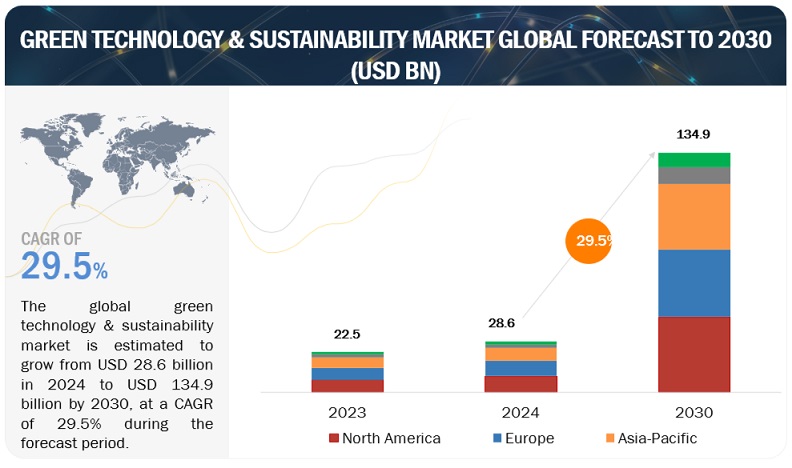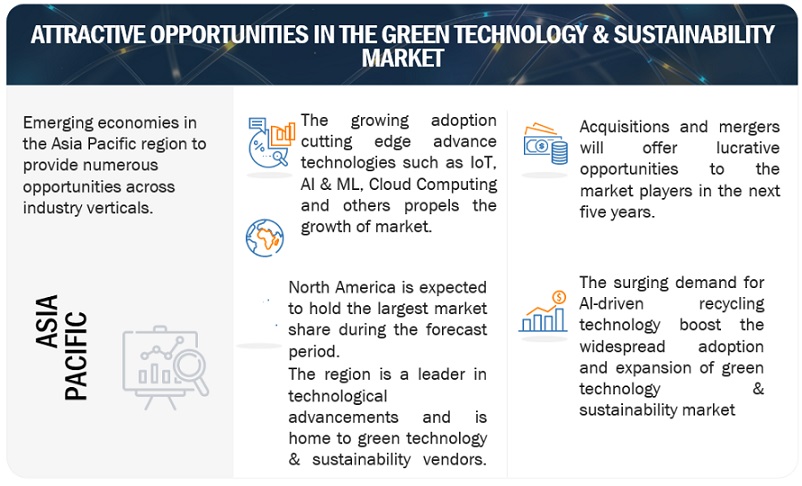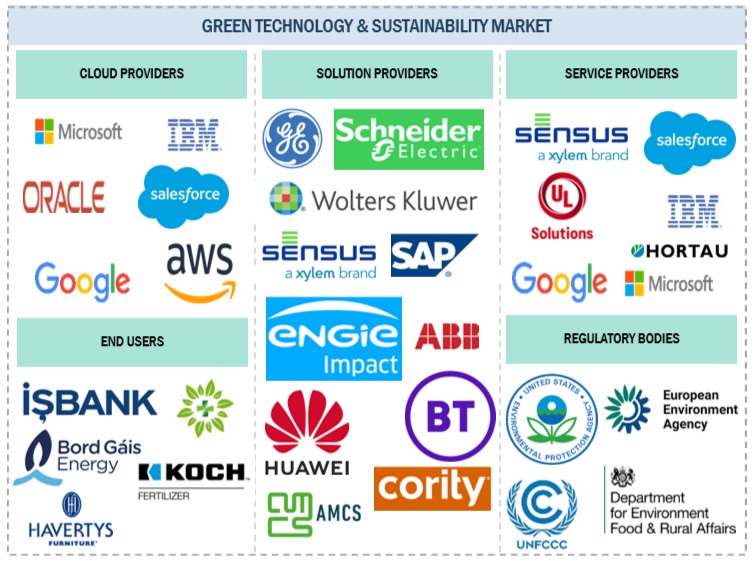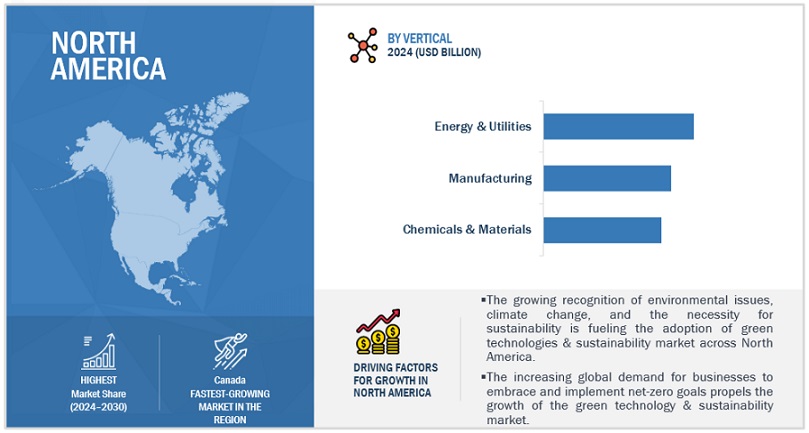※レポートは、MarketsandMarkets社が作成したもので英文表記です。
レポートの閲覧に際してはMarketsandMarkets社のDisclaimerをご確認ください。
Green Technology & Sustainability Market - Size, Growth, Report & Analysis
[323 Pages Report] The global Green Technology & Sustainability Market size was valued $28.6 billion in 2024. The revenue forecast for 2030 is set for the valuation of $134.9 billion. It is projected to grow at a CAGR of 29.5% during the forecast period (2024-2030). The base year for estimation is 2021 and the market size available for the years of 2019 to 2030.
Businesses globally are making substantial investments in green technology & sustainability to align with environmental goals and meet regulatory requirements. Investments span diverse areas, including renewable energy adoption, energy-efficient technologies, sustainable supply chain practices, and eco-friendly product development. Companies are allocating funds for research and development to innovate sustainable solutions and reduce their carbon footprint. Additionally, strategic partnerships and collaborations are forming to leverage collective expertise and resources. The investment landscape is characterized by a growing focus on Environmental, Social, and Governance (ESG) criteria, attracting capital from socially responsible investors.
Technology Roadmap of Green Technology & Sustainability till 2030
The Green technology & sustainability market report covers the technology roadmap till 2030, with insights into short-term, mid-term, and long-term developments.
Short-term roadmap (2024-2030)
- Focus on improving the efficiency of photovoltaic materials to enhance energy conversion in solar panels.
- Integration of AI algorithms for waste sorting and recycling optimization, enhancing the efficiency of recycling processes.
- Adoption of blockchain for transparent supply chains and traceability of agricultural products.
Long-term roadmap (2030 and beyond)
- Implementation of AI-driven decision support systems for precision farming, integrating automated crop monitoring and climate modeling.
- Integrating AI in building automation systems for adaptive energy management, optimizing energy use based on occupancy and environmental conditions.


Market Dynamics
Driver: Rising demand for AI-driven recycling technologies to fuel green innovations and sustainability
The surging demand for AI-driven recycling technology is a catalyst for the widespread adoption of green technology and the expansion of the sustainability market. AI's implementation in recycling processes, particularly in robotic sorting, supply chain optimization, and quality control, leads to heightened resource efficiency and decreased environmental impact. The integration of AI algorithms in waste management systems enhances real-time data analysis, facilitating dynamic decision-making for optimal sustainability outcomes. Businesses investing in AI-powered recycling solutions gain a competitive edge by showcasing environmental responsibility through streamlined processes and reduced carbon footprints. This strategic alignment with sustainability goals positions them favorably in the market, attracting consumers and fostering a positive corporate image. Furthermore, the technical advancements facilitated by AI in recycling transcend the immediate benefits, influencing broader innovations in green technology. This includes the development of energy-efficient practices, smart waste management systems, and sophisticated circular economy models. Consequently, the rising prominence of AI-driven recycling technologies plays a pivotal role in reshaping industries toward more technically advanced, sustainable, and environmentally resilient practices.
Restraint: Lack of robust infrastructure
The growth of green technology and the sustainability market is hampered by insufficient infrastructure, which extends to the inadequate integration of digital technologies. Digital tools play a crucial role in optimizing energy efficiency, monitoring environmental impact, and enhancing overall sustainability practices. However, the absence of a robust digital infrastructure impedes the seamless adoption and integration of these technologies. Smart grids, data analytics, and Internet of Things (IoT) devices, for instance, require a supportive digital framework for effective implementation. In the absence of such infrastructure, the potential benefits of digitization in optimizing resource usage and reducing environmental footprints remain unrealized. Addressing the digital divide and investing in digital infrastructure is essential to unlocking the full potential of green technology and fostering a sustainable future.
Opportunity: Adoption of advanced technologies, such as AI, IoT, and big data, across industries
Industries such as manufacturing, healthcare, and IT & telecom are highly adopting advanced technologies (IoT, Artificial Intelligence (AI), and big data), which helps them calculate the carbon emission by their respective business divisions and take appropriate action on the same. According to PwC and Microsoft, using AI could reduce worldwide GHG emissions by 4% in 2030, an amount equivalent to 2.4 gigatons equivalent (GTCO2e) of carbon dioxide (CO2) emissions equivalent to the 2030 annual emissions of Australia, Canada, and Japan combined. PwC and Microsoft predicted that environmentally oriented AI applications carry a big GHG mitigation potential for almost all regions, with North America and East Asia, potentially reducing their GHG emissions by 1.6% to 6.1% and 2.7% to 4.8% in 2030, respectively. In the transportation and logistics industry, IoT devices were used to monitor route optimization leading to saving of fuel. Hence, adopting advanced technologies is expected to create opportunities for green technology & sustainability software providers in the near future.
Challenge: Lack of regulations for green technology
The adoption of green technology requires a uniform legal framework. Since various products are initially developed in industrialized countries, technology transfer from developed to developing countries is a necessary part of the green technology & sustainability process. In most countries, there is no dedicated consigned body to govern these policies; these countries implement regulatory policies based on their regional factors, such as macroeconomic and political risk factors, along with their business requirements. Enterprises have been implementing green technology with the help of IoT, AI, analytics, cloud, and security solutions to better manage business risks and comply with regulations. The varying structure of regulatory policies, along with the changing macroeconomic factors, makes it difficult for vendors to meet the end-user requirements. Some organizations, especially in regions where there are no proper governing and regulatory bodies, tend to implement in-house regulatory guidelines and policies.
Green Technology & Sustainability Market Ecosystem

By vertical, energy & utilities accounts for the largest market size during the forecast period.
The energy and utility vertical is driving the growth of the green technology & sustainability market, with the segment expected to account for the largest market size during the forecast period. The adoption of renewable energy sources, smart grid technologies, energy efficiency, and sustainable transportation are some of the key factors contributing to the growth of the green technology & sustainability market in the energy and utility sector. The growing number of initiatives by governments to increase the share of non-fossil fuel energy and reduce carbon emissions is also driving the adoption of green technologies in the energy and utility sector.
Based on the technology, AI & ML holds the highest CAGR during the forecast period.
AI & ML are profoundly influencing the green technology & sustainability market, driving innovation and efficiency across various sectors. In energy management, AI optimizes power consumption, grid operations, and enhances renewable energy integration, maximizing overall efficiency. ML algorithms analyze vast datasets to improve predictive maintenance, reducing downtime and resource waste in sustainable infrastructure. Smart resource management through AI-driven solutions minimizes water usage, waste generation, and enhances overall environmental impact. Additionally, in supply chain and logistics, AI enhances transparency, enabling businesses to make sustainable sourcing decisions.
By deployment mode, the cloud accounts for the largest market size during the forecast period.
Cloud technology has significantly impacted the green technology & sustainability market by enhancing efficiency and reducing environmental impact. Cloud solutions enable organizations to optimize resource utilization, leading to energy efficiency and lower carbon footprints. Through server virtualization and dynamic resource allocation, cloud providers achieve economies of scale, maximizing the use of hardware and minimizing energy consumption. Moreover, cloud-based services facilitate remote collaboration and data sharing, reducing the need for extensive travel and physical infrastructure. This contributes to decreased greenhouse gas emissions associated with traditional business operations..
North America to account for the largest market size during the forecast period.
In North America, the adoption of green technology & sustainability is influenced by a combination of technological advancements and regulatory measures. Government regulations play a crucial role in shaping the landscape. For instance, stringent emission standards and renewable energy targets have been implemented, fostering a conducive environment for sustainable practices. Compliance with these regulations has led to a surge in investment in clean energy technologies.

Key Market Players
The Green technology & sustainability vendors have implemented various types of organic and inorganic growth strategies, such as partnerships and agreements, new product launches, product upgrades, business expansions, and mergers and acquisitions to strengthen their offerings in the market. The major vendors in the global market for Green technology & sustainability GE (US), IBM (US), Salesforce (US), Microsoft (US), Schneider Electric (France), Sensus (US), Wolters Kluwer (Netherlands), SAP (Germany), Siemens (Germany), Oracle (US), Engie Impact (US), AWS (US), Google (US), ABB (Switzerland), Huawei (China), BT Group (UK), AMCS Group (Ireland), Cority (Canada), Intelex (Canada), Treeni (India), IsoMetrix (US), ConsenSys (US), CropX Technologies (Israel), Hortau (US), Pycno (UK), Wint (US), Envirosoft (Canada), Trace Genomics (US), Taransi (US), Oizom (India), Treevia Forest Technologies (Brazil), Factlines (Norway), ENECHANGE (Japan), EcoCart (US), AquiPor Technologies (US).
Get online access to the report on the World's First Market Intelligence Cloud
- Easy to Download Historical Data & Forecast Numbers
- Company Analysis Dashboard for high growth potential opportunities
- Research Analyst Access for customization & queries
- Competitor Analysis with Interactive dashboard
- Latest News, Updates & Trend analysis
Get online access to the report on the World's First Market Intelligence Cloud
- Easy to Download Historical Data & Forecast Numbers
- Company Analysis Dashboard for high growth potential opportunities
- Research Analyst Access for customization & queries
- Competitor Analysis with Interactive dashboard
- Latest News, Updates & Trend analysis
Scope of the Report
|
Report Metrics |
Details |
|
Market size available for years |
2019–2030 |
|
Base year considered |
2023 |
|
Forecast period |
2024–2030 |
|
Forecast units |
USD Billion |
|
Segments Covered |
Offering, Technology, Verticals, and Region |
|
Geographies covered |
North America, Europe, Asia Pacific, Middle East & Africa, and Latin America |
|
Companies covered |
GE (US), IBM (US), Salesforce (US), Microsoft (US), Schneider Electric (France), Sensus (US), Wolters Kluwer (Netherlands), SAP (Germany), Siemens (Germany), Oracle (US), Engie Impact (US), AWS (US), Google (US), ABB (Switzerland), Huawei (China), BT Group (UK), AMCS Group (Ireland), Cority (Canada), Intelex (Canada), Treeni (India), IsoMetrix (US), ConsenSys (US), CropX Technologies (Israel), Hortau (US), Pycno (UK), Wint (US), Envirosoft (Canada), Trace Genomics (US), Taransi (US), Oizom (India), Treevia Forest Technologies (Brazil), Factlines (Norway), ENECHANGE (Japan), EcoCart (US), AquiPor Technologies (US) |
This research report categorizes the Green technology & sustainability market based on Offering, Analytics Type, Business Functions, Verticals, and Region.
By Offering:
-
Solution
-
By Deployment Mode
- Cloud
- On-Premises
-
By Deployment Mode
-
Services
-
Professional Services
- Consulting
- Integration & Deployment
- Support & Maintenance
- Managed Services
-
Professional Services
By Technology:
- Internet Of Things
- AI & ML
- Digital Twins
- Cloud Computing
- Blockchain
- Edge Computing
- Cybersecurity
By Verticals:
- Retail & Consumer Goods
- Automotive & Transportation
- Energy & Utilities
- Chemicals & Materials
- Manufacturing
- Agriculture
- BFSI
- Healthcare & Life Sciences
- Others Verticals
By Region:
-
North America
- US
- Canada
-
Europe
- UK
- Germany
- France
- Italy
- Spain
- Rest of Europe
-
Asia Pacific
- China
- Japan
- India
- South Korea
- Singapore
- ANZ
- Rest of Asia Pacific
-
Middle East & Africa
- UAE
- Kingdom of Saudi Arabia
- Qatar
- Egypt
- South Africa
- Rest of the Middle East & Africa
-
Latin America
- Brazil
- Mexico
- Argentina
- Rest of Latin America
Recent Developments:
- GE Healthcare and Amgen have announced a digital data exchange program to improve the understanding of the relationship between raw material variability and process performance during the manufacturing of biological medicines. They will connect GE Healthcare's raw material manufacturing sites with Amgen's process development center in Cambridge, MA.
- Deloitte and IBM have collaborated to offer sustainability solutions to help organizations accelerate their sustainability outcomes. The collaboration enables clients to leverage multiple IBM solutions and integrate data from the IBM Envizi ESG Suite with Deloitte's GreenLight Solution. The solutions offered to GreenLight Solution clients under the collaboration include ESG data, green facilities and operations, green IT and cloud migrations, and facilities and workplace management.
- Salesforce has partnered with Accenture to expand its alliance to help companies embed sustainability into their business, meet growing customer and stakeholder expectations, and contribute to advancing the United Nations Sustainable Development Goals (SDGs). Salesforce has also issued its inaugural Sustainability Bond offering, totaling USD 1 billion, as part of an USD 8 billion underwritten public offering of senior notes.
- Fujitsu and Microsoft have entered a five-year strategic partnership to expand collaboration, with a primary emphasis on sustainability transformation. The partnership is expected to drive joint efforts in developing technologies and solutions for environmental and social sustainability..
- HCLTech and Schneider Electric are collaborated to develop carbon-efficient solutions for data centers in the Asia-Pacific region, aiming to reduce emissions and enhance environmental sustainability.
Frequently Asked Questions (FAQ):
What is Green technology & sustainability?
Green technology & sustainability encompass a diverse array of digital technologies implementation aimed at minimizing environmental impact. These initiatives contribute to reduced energy and water consumption, waste reduction, lower carbon footprint, and enhanced business efficiency, leading to cost savings. Additionally, the focus on sustainable practices fosters innovative product design and creates employment opportunities, reflecting a holistic approach toward environmental responsibility and economic benefit.
Which countries are considered in the European region?
The report includes an analysis of the UK, Germany, France, Spain, and Italy in the European region.
Which are key verticals adopting Green technology & sustainability?
Key verticals adopting Green technology & sustainability include retail & consumer goods, automotive & transportation, energy & utilities, chemicals & materials, manufacturing, agriculture, BFSI, healthcare & life sciences, and others (government, IT/ITeS, telecommunication, construction & real estate).
Which are the key drivers supporting the market growth for Green technology & sustainability?
The key drivers supporting the market growth for the Green technology & sustainability market include growing awareness and concern towards the environment, Increase in government initiatives for low-carbon policies, Increasing consumer and industrial interest for use of clean energy resources to conserve the environment, Rising demand for AI-driven recycling technologies to fuel green innovations and sustainability.
Who are the key vendors in the market for Green technology & sustainability?
The key vendors in the global Green technology & sustainabilitymarket include GE (US), IBM (US), Salesforce (US), Microsoft (US), Schneider Electric (France), Sensus (US), Wolters Kluwer (Netherlands), SAP (Germany), Siemens (Germany), Oracle (US), Engie Impact (US), AWS (US), Google (US), ABB (Switzerland), Huawei (China), BT Group (UK), AMCS Group (Ireland), Cority (Canada), Intelex (Canada), Treeni (India), IsoMetrix (US), ConsenSys (US), CropX Technologies (Israel), Hortau (US), Pycno (UK), Wint (US), Envirosoft (Canada), Trace Genomics (US), Taransi (US), Oizom (India), Treevia Forest Technologies (Brazil), Factlines (Norway), ENECHANGE (Japan), EcoCart (US), AquiPor Technologies (US). .


